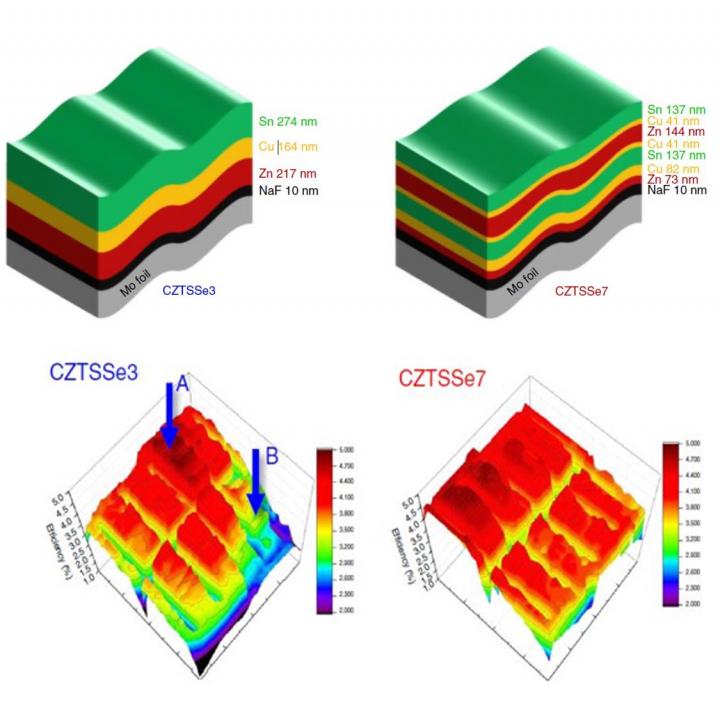DGIST achieves the highest efficiency of flexible CZTSSe thin-film solar cell

(A) A comparison diagram of the existing 3-story structure of CZTSSe solar cell (left) and the newly developed multi-story structure (right) (B) A mimetic diagram showing the differences of efficiency and uniformity between the existing 3-story structure of CZTSSe solar cell (left) and the newly developed multi-story structure (right) Credit: DGIST
Flexible thin-film solar cell can be applied in various fields such as wearable, building, and automobiles based on the flexible substrate technology.
Since CZTSSe thin-film solar cell uses low-cost, ecofriendly materials, it is drawing limelight and is being researched as the next generation solar power technology throughout the world. However, Flexible CZTSSe`s photoelectric conversion efficiency had not exceeded 10% due to technological issue such as the spread of impurities inside the flexible substrate and delamination.
In response, the DGIST research team conducted research and achieved the highest efficiency of 11.4%, which was officially recognized. This achievement is drawing more attention because its mass production is much easier with the use of low-cost, ecofriendly materials such as copper(Cu), zinc(Zn), tin(Sn) than the existing thin-film solar cell (CIGS, CdTe, perovskite2), which uses high-cost heavy metal materials such as indium, lead, and cadmium.
One of the biggest achievements of this research is increased efficiency by changing the existing 3-stack structure of CZTSSe thin-film solar cell precursor into a multi-layered structure and by improving the voltage characteristics and uniformity.
Moreover, it has the problem with uniformity degradation when a large-area process is applied to thin-film solar cell, but applied process technology in this research improved not only efficiency but also uniformity.
Dr. Kee-Jeong Yang who led the development of process technology said “Our research achievement has presented ways to secure the uniformity of large-area process, which can cause issues in commercialization. We will be able to advance the commercialization of next generation solar cell which is applicable in various fields such as building outer walls.”
Moreover, Senior Researcher Jin-Kyu Kang, the research project manager, said “As there is growing interest towards environment and resources are used unlimitedly these days, it is a very meaningful achievement that we have developed a thin-film solar cell using widely available, ecofriendly materials. We plan to lead the future solar cell technology using widely available materials and contribute to the development of thin-film solar cell industry.
###
This research was carried out as a project “Development of earth abundant, non-toxic chalcogenide absorber based flexible inorganic thin film solar cell” with support by Korea Energy Technology Evaluation and Planning (KETEP), which is affiliated under the Ministry of Trade, Industry, and Energy. DGIST plans to open the Research Center for Thin Film Solar Cell based on this achievement. Its precursor design technology was published on international journal Nature Communications on July 4.
1 Photoelectric conversion: Conversion of light energy into electric energy.
2 Perovskite: A crystal structure with excellent electrical conductivity, created by mixing methyl ammonium, formamidium, and inorganic and organic matters. Forms electrons when receives light and produces electricity like regular solar cell.
Media Contact
All latest news from the category: Power and Electrical Engineering
This topic covers issues related to energy generation, conversion, transportation and consumption and how the industry is addressing the challenge of energy efficiency in general.
innovations-report provides in-depth and informative reports and articles on subjects ranging from wind energy, fuel cell technology, solar energy, geothermal energy, petroleum, gas, nuclear engineering, alternative energy and energy efficiency to fusion, hydrogen and superconductor technologies.
Newest articles

NASA: Mystery of life’s handedness deepens
The mystery of why life uses molecules with specific orientations has deepened with a NASA-funded discovery that RNA — a key molecule thought to have potentially held the instructions for…

What are the effects of historic lithium mining on water quality?
Study reveals low levels of common contaminants but high levels of other elements in waters associated with an abandoned lithium mine. Lithium ore and mining waste from a historic lithium…

Quantum-inspired design boosts efficiency of heat-to-electricity conversion
Rice engineers take unconventional route to improving thermophotovoltaic systems. Researchers at Rice University have found a new way to improve a key element of thermophotovoltaic (TPV) systems, which convert heat…



